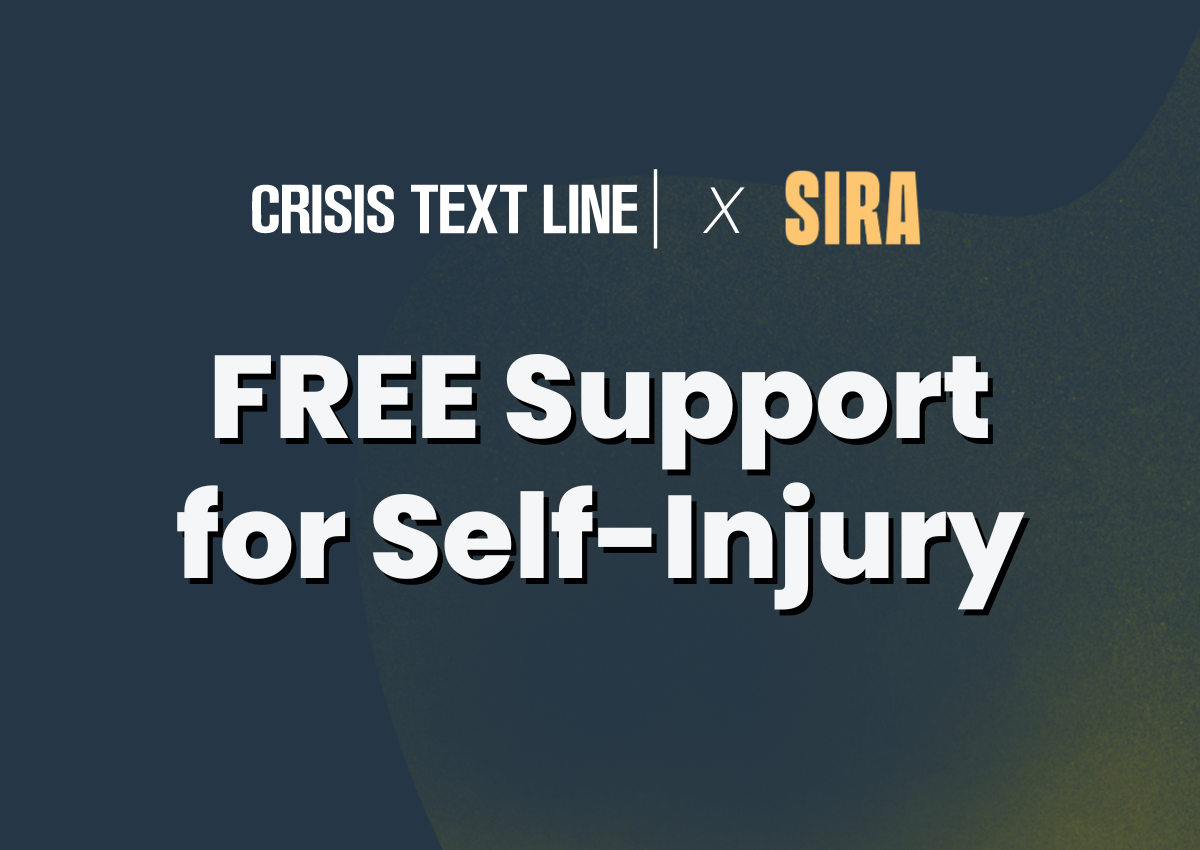FREE Support for Self-Injury | Text SH to 741741

If you are feeling overwhelmed and have the urge to self-injure, it is important to remember that you are not alone. There are people who genuinely care about your well-being and want to support you through this difficult time. If you need support, we encourage you to reach out for help by texting SH to 741741.
What is self-injury?
The International Society for the Study of Self-Injury defines Non-Suicidal Self-Injury (NSSI) as the deliberate, self-directed damage of body tissue without suicidal intent and for purposes not socially or culturally sanctioned.
Self-injury always goes back to intent–are you inflicting physical harm on yourself to regulate your emotions? Self-injury is not the same as suicide. On the contrary, one is going to great lengths to stay alive. However, there is a high correlation between people who engage in self-injury, suicidal ideation and attempts.
Cornell’s Self-Injury & Recovery Resources list some of the behaviors that constitute self-injury including cutting, burning, banging or punching objects or oneself with the intention of hurting one’s self, intentional carving, amongst other forms of self-injury. Through Cornell’s studies, the organization has found 16 forms of NSSI, and there may be more.
Difference between self-harm and self-injury
Although self-harm is the most commonly used term when referring to self-injury, self-harm is an umbrella term. Many behaviors can fall under the self-harm umbrella i.e.(eating disorders, unintentional self-injury, psychological injury, and reckless behavior). NSSI falls under the self-harm umbrella however, the intent differentiates NSSI from other self-harm behaviors.
Did I engage in self-injurious behavior(s)?
If you are not sure if you are engaging in self-injury, it’s important to reflect and investigate the action. Below are some questions that have helped people with lived experience answer this question.
- Was the outcome to physically hurt yourself? Keep in mind, self-injury is immediate and deliberate.
- What led you to engage in this behavior?
- Was there a trigger?
- What emotions came up before, during, and after?
- Did the behavior provide temporary relief?
- What were you looking to achieve and gain from engaging in this behavior?
- What emotions came up after the act apart from relief i.e. ( remorse, shame, etc.)?
If you are looking to reflect more, the non-profit Self-Injury Recovery & Awareness (SIRA) provides guiding questions called “Layers to Discovery” to help you uncover the “why” behind your self-injury. Keep in mind, there is no “right” way to answer the layers as it is subjective and everyone’s NSSI journey is unique to them.
Why do people self-injure?
There are many reasons why someone engages in self-injury as the behavior is complex. Below are some of the reasons why one may engage in the behavior.
- To gain a sense of control.
- To stop racing thoughts.
- Seeking to feel something.
- Looking to numb one’s emotions.
- There may not be a reason during some NSSI episodes (and that’s ok).
- Punishment.
- “Failing” to meet personal standards of achievement/ perfectionist mindset.
- Low self-esteem & self-hatred.
- Wanting to handle emotions on your own to not feel like a burden.
- Relief from emotional pain and distress/emotion regulation.
Is self-injury an addiction?
Experts have stated that self-injury has addictive-like qualities. Many people with lived experience would consider their self-injury an addiction. People who engage in self-injury and also struggle with substance abuse have stated that they see similarities between self-injury and their addiction to drugs. Studies by Cornell’s Self-Injury & Recovery Resources state that interviewees liken it to other drugs and talk about needing increasingly more or deeper injuries to feel the same effect.
For some, considering self-injury as an addiction sometimes helps with their recovery process, as naming it is helpful. People with lived experience state this allows them to take their self-injury recovery as seriously as their recovery to drugs, for example.
Some studies have shown inflicting pain changes a person’s mood, producing endorphins and over time, the body can become, in a sense, addicted to these pain-relieving neurotransmitters. The impulse to self-injure arises from a craving for endorphins. It’s a counterproductive approach that produces benefits.
How to get help for self-injury?
NSSI experts have stated that there is “no gold standard” treatment. There is not a one-size-fits-all recovery plan. People with lived experience have found it beneficial to try out different techniques throughout their self-injury recovery journey. Self-injury reduction has shown to be the best course of action when working towards a self-injury free life. Below are a few recovery and educational resources.
- SIRA is a non-profit that is dedicated to helping people recover from self-injury through a peer-support group model.
- Cornell Self-Injury & Recovery Resources
- The International Society for the Study of Self-Injury
- To Write Love on Her Arms
- Calm Harm App
- The Psychology of Self-Injury Podcast by Dr. Nicholas Westers
What are some safe alternatives?
Below are techniques for you to consider trying when urges arise. It may not help every time, but it’s important to not give up and to know you may not always receive the immediate effects right away. Having a variety of healthy coping skills in your tool box is important so you can see what works best for you.
It’s ok if you end up engaging in the behavior during your recovery process. It is a journey and self-compassion is a necessary component when working towards a self-injury free life. Remember to give yourself grace.
- Create a call list.
- Write a list of confidants who you can call when urges arise. Be sure to ask them if they are comfortable being added to your call log. Some people separate their list into morning, day, and night. The night can be especially hard for people who engage in self-injury. Having family and/or friends who are night owls would be the best people to have under your night call log.
- Create a playlist. Listen to your dedicated playlist when urges arise.
- Crafting. Keep your hands busy. Puzzles, painting, play doh, fidget toys have been helpful for people when trying to decrease urges.
- Time yourself.
- See if you can go 5 minutes, for example, without engaging in self-injury. Try to keep increasing the amount of time. Perhaps you can stretch it to hours or even days. The purpose of this exercise is to show yourself that you can refrain from self-injury for an allocated amount of time you set for yourself. Build your confidence, you got this!
- Take a shower.
- Make a list (on your phone or paper) of small steps you can take to regulate. Example: 1. Drink water. 2. Meditate. 3. Take a shower. 4. Eat something. 5. Watch a show/movie that makes you happy. Sometimes going back to basics can get you out of your head and help the urges subside. Keep adding more steps if you’d like, but do not overwhelm yourself, keep it simple.
- Emotional Freedom Technique (EFT, Tapping).
Understanding self-injury requires compassion, empathy, and a commitment to breaking the stigma. At Crisis Text Line, we are always working to provide support and resources for those who are battling with self-harm, encouraging open dialogue, and fostering environments where seeking help is met with understanding rather than judgment. If you, or someone you know is struggling with self-harm, we encourage you to reach out by texting SH to 741741, our live Crisis Counselors are always there to support you.

